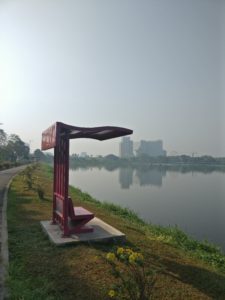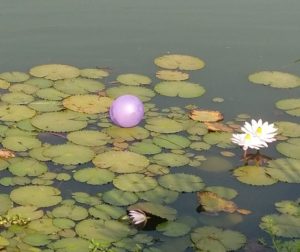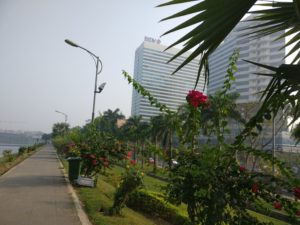An elderly Myanmar man was dangling his parasol from one finger while he placed his hands on his back and swiveled his hips in a circle, stretching. I felt myself smiling. Another middle-aged couple was barefoot in the grass performing some exercises together in the morning breeze. Young boys on bicycles whizzed by and plenty of locals were relaxing by the water on shaded benches. 
Loving Myanmar
Today I set out on a walk having no idea where I wanted to go. It was early and I wanted to take advantage of some cool air before the sun burned through the haze and turned the sidewalk into a human frying pan. I set out around the lake, focused on my breath, and tried to let the thoughts that entered my mind just pass on through. When the locals smiled at me, I smiled back. Young boys giggled at my shorts and my attempts to greet them in the local language “Mingalabar”. And I struggled to find my center.

Enjoying the Moment
 I heard the heavy traffic moving slowly behind me, the smells of the gorgeous flowers and the dirty lake. Birds fished in the water, bobbing beneath the surface over and over again only occasionally coming up with something flopping in their beaks.
I heard the heavy traffic moving slowly behind me, the smells of the gorgeous flowers and the dirty lake. Birds fished in the water, bobbing beneath the surface over and over again only occasionally coming up with something flopping in their beaks.
As I was examining the plants, a familiar one suddenly caught my eye, mimosa pudica, also called the sensitive plant because of how it closes up when it is touched. The tiny purple flowers attracted my attention and I couldn’t resist touching it and taking a picture.
Mindfulness for Narcolepsy
I remembered an article I saw recently about photography being used to practice mindfulness. It explained that photography is a “physical manifestation of mindfulness.” I’ve never actually heard of mindfulness for narcolepsy, but I think it should be a thing. When we are present and paying full attention to the moment, we are more awake.

My walk continued as I used this practice; looking up into the trees above and closely at the surface of the water and the ground beneath my feet. I practiced slowing down and being present in the moment as I appreciated everything I was feeling, hearing, and especially seeing around me.

These stunning water lilies caught my eye, with a latex balloon floating next to them. After the initial annoyance at the pollution of such a beautiful place, I thought of how many metaphors I could make from that image.
As the heat increased I saw fewer people relaxing around the lake. I realized I had spent over an hour in this small area appreciating everything around me. Only being present in the moment and not thinking about the past or the future. 
I hope to repeat this experience many times in the future. It brought me feelings of gratitude for where I am in life. I felt inspired to share my experience using mindfulness for narcolepsy. There are other ways to do it without even leaving your house.
Mindfulness Practice
Have you ever used mindfulness for narcolepsy? I would love to hear about your experience. Using meditation is widely known to be beneficial to one’s health. But as a person with narcolepsy, I initially thought it wasn’t possible for me since closing my eyes generally means falling asleep. However, I have found that that doesn’t have to be the case. I was able to actually train myself to control my awareness even when my eyes are closed. It’s important to be kind to yourself as you ease into this practice. If you do fall asleep, don’t beat yourself up. Sometimes mindfulness is about giving your body what it needs. Here is my advice for getting started with mindfulness.
How to practice mindfulness for narcolepsy
- You can begin with more active mindful activities, like the photography I spoke about above. Really practice bringing your awareness to the surface.
- Once that comes more naturally, try it when you are seated in a chair in a quiet place. Spend a few minutes just being aware of yourself and your breath. Feel your thighs on the seat and your feet on the floor. It doesn’t have to last for a long time, just a minute or two can shift your attention to a different space and
 make a difference in your day.
make a difference in your day. - Increase the time that you spend paying attention to your breath and sitting in silence. During your mindfulness practice, try to let go of any thoughts that pop into your head. You may think of things you need to do or something that you said yesterday, that is normal. Practice just acknowledging the thought, and letting it go without fixating on it or passing judgment. If this part is difficult for you, I will refer you to the best advice I’ve heard on this subject from another person with narcolepsy, Dawn from Going Beyond Coping. She calls it Killing the Monkeys in Your Mind, AKA Clearing Your Thoughts.
- Once you can find that place of inner peace, even for just a moment, you can start meditating for longer time periods. Each time your mind wanders, just remember you have been to that place of inner peace so you know the way back there. It’s like finding a place in your neighborhood for the first time. But each time you go back, it’s easier.
- Let me know how it goes. I don’t want to tell you about the wide range of benefits mindfulness has brought to my life, I’d rather you experience it for yourself and tell me. Can mindfulness for narcolepsy really be a thing?
mhm… I am eager to see those photos. Could you re-upload them? 🙂 thank you
Thanks for noticing! I have fixed it now 😉